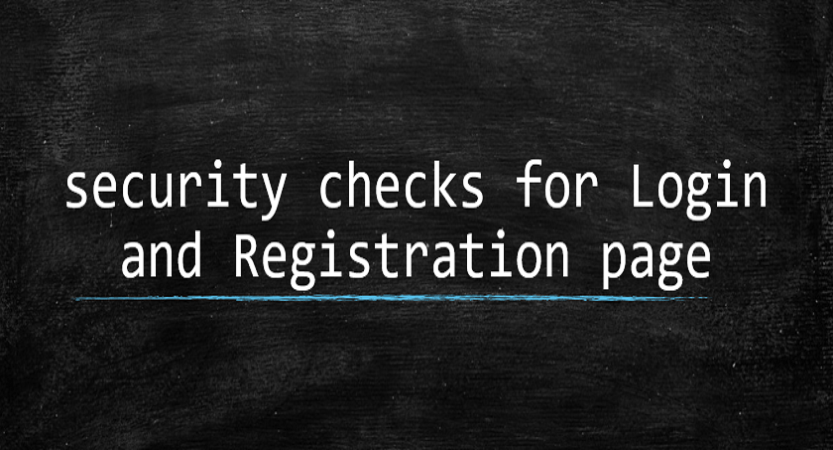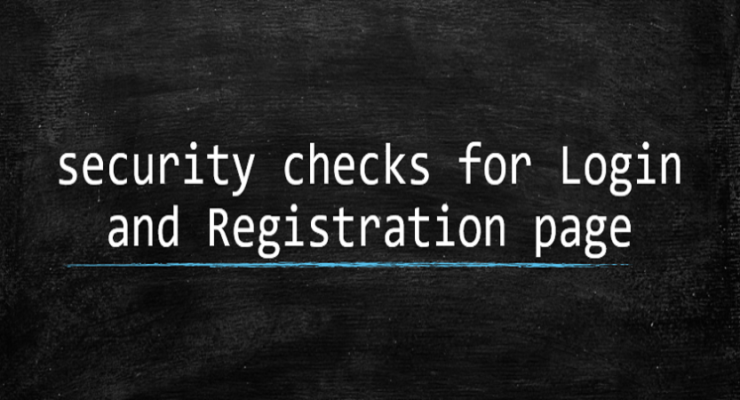Introduction:
As a cyber security consultant, it is crucial to prioritize the security of login and registration systems. These systems are the gateway to accessing sensitive user information, making them attractive targets for attackers. This article will explore various subheadings highlighting the critical aspects of securing “Login and Registration” processes.
Note: For payload, refer to the link at the bottom of the page
Authentication Methods:
Authentication is a fundamental aspect of login and registration systems. It verifies the identity of users and ensures that only authorized individuals can access the system.
Commonly used, three primary authentication methods exist.
1.1 Form-Based Authentication:
Form-based authentication involves using a login form to collect user credentials, such as usernames and passwords. The server validates these credentials before granting access to the system.
Example of Form-Based Authentication:
For instance, a website may present a login form with fields for the username and password. Upon submission, the server verifies the entered credentials against its database before granting access to the system.
1.2 Cookie-Based Authentication:
Cookie-based authentication relies on session cookies to authenticate users. A session cookie is created and stored on the device when a user logs in. This cookie is then used to validate subsequent requests from the user.
Example of Cookie-Based Authentication:
Consider a scenario where a user logs in to an online banking portal. After successful authentication, a session cookie is created and stored on the user’s device. Subsequent requests from the user include this cookie, allowing the server to validate the user’s session.
1.3 Header-Based Authentication:
Header-based authentication utilizes tokens in HTTP request headers to authenticate users. These tokens, often JSON Web Tokens (JWT), contain encrypted information about the user’s identity and privileges.
Example of Header-Based Authentication:
Imagine a mobile application that uses header-based authentication with JSON Web Tokens (JWT). A JWT containing encrypted user information is generated when a user logs in. This token is then included in the headers of subsequent requests to authenticate the user.
Registration Page Types:
Registration pages are the entry point for new users to join a system. There are two common types of registration pages:
2.1 Closed Registration:
Closed registration allows only a select group of individuals to create accounts. This approach is suitable for applications requiring exclusivity or specific membership criteria.
Example of Closed Registration:
An example of closed registration is a private online community restricting membership to specific individuals, such as an exclusive professional networking platform accessible only to verified professionals in a particular industry.
2.2 Open Registration:
Open registration allows anyone to create an account without restrictions. This approach is commonly used for public-facing applications or services that aim to attract a broad user base.
Example of Open Registration:
An open registration example could be a social media platform that allows anyone to create an account, targeting a broad user base and encouraging widespread participation.
Vulnerabilities to Check:
Ensuring the security of login and registration systems requires identifying and addressing potential vulnerabilities. Here are some vulnerabilities to be aware of:
3.1 Injection Vulnerabilities:
Injection vulnerabilities, such as SQL injection (SQLi), can enable attackers to manipulate database queries and gain unauthorized access. Common injection attacks include modifying input fields to exploit poorly constructed SQL queries.
Example of Injection Vulnerabilities:
Consider a scenario where an attacker manipulates an input field in a web form, inserting malicious SQL code. This code exploits a poorly constructed SQL query and grants unauthorized access to the database.
3.2 LDAP Injection:
LDAP injection occurs when user input is not properly sanitized before being used in Lightweight Directory Access Protocol (LDAP) queries. Attackers can manipulate information to execute unintended LDAP commands and potentially gain unauthorized access.
Example of LDAP Injection:
In an application using LDAP for user authentication, an attacker may craft input that contains LDAP commands. If the application fails to sanitize the information correctly, these commands can be executed, potentially leading to unauthorized access.
3.3 Numeric Injection:
The numeric injection targets web applications that use numeric parameters in SQL queries. By manipulating numeric input fields, attackers can bypass input sanitization and execute malicious database operations.
3.4 Blind SQL Injection:
Attackers exploit vulnerabilities in blind SQL injection by suppressing or hiding error messages. Attackers can use techniques like time-based delays or sleep commands to extract sensitive information indirectly.
Example:
A login page, most of the time, generate SQL query such as those below
SELECT * FROM Users WHERE Name = ‘INPUT’ AND Pass = ‘INPUT.’
For example, SELECT * FROM Users WHERE Name =’ OR ‘1’ =‘1′ AND Pass =” OR ‘1’ =‘1′
Session Management:
Effective session management is crucial to maintain secure user sessions. Consider the following aspects:
4.1 Session Timeout:
Implementing session timeouts helps protect against session hijacking and unauthorized access by automatically terminating idle sessions after a predefined period.
Example of Session Timeout:
Suppose a web application automatically logs out a user after 15 minutes of inactivity. This timeout helps prevent unauthorized access to the user’s session if they forget to log out manually.
4.2 Password Reset Vulnerability:
Password reset functionality should be designed with security in mind. Use secure token-based approaches to generate password reset links that are time-limited and resistant to tampering.
Example of Password Reset Vulnerability:
When a user initiates a password reset, the system generates a unique, time-limited token and includes it in the password reset link. This token ensures that only the intended user can reset their password within a specific timeframe.
4.3 Cookie Security:
Ensure secure handling and storage of session cookies to prevent unauthorized access. Implement HttpOnly and Secure flags to mitigate cross-site scripting (XSS) attacks and enforce cookie encryption.
Additional Security Measures:
To enhance the security of login and registration systems, consider implementing the following measures:
5.1 Account Lockout:
Enforce account lockout mechanisms after multiple failed login attempts to mitigate brute-force attacks. Implement intelligent rate-limiting based on IP addresses or usernames.
Example of Account Lockout:
To protect against brute-force attacks, a system may temporarily lock a user’s account after several consecutive failed login attempts, such as closing a charge for 30 minutes after five failed attempts.
5.2 CSRF Protection:
Implement Cross-Site Request Forgery (CSRF) protection mechanisms to prevent attackers from tricking authenticated users into performing unintended actions.
Example of CSRF Protection:
Implementing CSRF tokens in forms can prevent attackers from tricking authenticated users into unknowingly performing actions on their behalf, such as submitting a malicious document.
5.3 Click-jacking Prevention:
Employ defences against click-jacking attacks by utilizing frame-busting techniques and implementing X-Frame-Options headers.
Example of Click-jacking Prevention:
A website can utilize X-Frame-Options headers to prevent click-jacking attacks, ensuring that the website is displayed within a designated frame and not embedded in malicious websites.
5.4 XSS Mitigation:
Apply input validation and output encoding to prevent cross-site scripting (XSS) attacks. Use security libraries or frameworks that offer built-in protection against XSS vulnerabilities.
Example of XSS Mitigation:
By employing input validation and output encoding, a web application can prevent the execution of malicious scripts injected through user-generated content or input fields.
5.5 Response Error Checking:
Thoroughly analyze error messages and responses to identify potential information leakage or improper handling of errors that could aid attackers.
Example of Response Error Checking:
To avoid potential information leakage, a web application should carefully handle error messages and responses, ensuring they do not reveal sensitive information or aid attackers.
Conclusion:
The security of login and registration systems is of utmost importance in safeguarding user data and against unauthorized access. By implementing robust authentication methods, addressing vulnerabilities, and employing additional security measures, organizations can significantly enhance the security posture of their login and registration processes.
Remember, the evolving nature of cybersecurity requires continuous monitoring, regular vulnerability assessments, and prompt remediation to stay ahead of potential threats.
(Note: The content of this article is for informational purposes only. Always consult security professionals and adhere to best practices and industry standards when implementing security measures.
Introduction:
As a cyber security consultant, it is crucial to prioritize the security of login and registration systems. These systems are the gateway to accessing sensitive user information, making them attractive targets for attackers. This article will explore various subheadings highlighting the critical aspects of securing “Login and Registration” processes.
Note: For payload, refer to the link at the bottom of the page
Authentication Methods:
Authentication is a fundamental aspect of login and registration systems. It verifies the identity of users and ensures that only authorized individuals can access the system. There are three primary authentication methods commonly used:
1.1 Form-Based Authentication:
Form-based authentication involves using a login form to collect user credentials, such as usernames and passwords. The server validates these credentials before granting access to the system.
Example of Form-Based Authentication:
For instance, a website may present a login form with fields for the username and password. Upon submission, the server verifies the entered credentials against its database before granting access to the system.
1.2 Cookie-Based Authentication:
Cookie-based authentication relies on session cookies to authenticate users. A session cookie is created and stored on the device when a user logs in. This cookie is then used to validate subsequent requests from the user.
Example of Cookie-Based Authentication:
Consider a scenario where a user logs in to an online banking portal. After successful authentication, a session cookie is created and stored on the user’s device. Subsequent requests from the user include this cookie, allowing the server to validate the user’s session.
1.3 Header-Based Authentication:
Header-based authentication utilizes tokens in HTTP request headers to authenticate users. These tokens, often JSON Web Tokens (JWT), contain encrypted information about the user’s identity and privileges.
Example of Header-Based Authentication:
Imagine a mobile application that uses header-based authentication with JSON Web Tokens (JWT). A JWT containing encrypted user information is generated when a user logs in. This token is then included in the headers of subsequent requests to authenticate the user.
Registration Page Types:
Registration pages are the entry point for new users to join a system. There are two common types of registration pages:
2.1 Closed Registration:
Closed registration allows only a select group of individuals to create accounts. This approach is suitable for applications requiring exclusivity or specific membership criteria.
Example of Closed Registration:
An example of closed registration is a private online community restricting membership to specific individuals, such as an exclusive professional networking platform accessible only to verified professionals in a particular industry.
2.2 Open Registration:
Open registration allows anyone to create an account without restrictions. This approach is commonly used for public-facing applications or services that aim to attract a broad user base.
Example of Open Registration:
An open registration example could be a social media platform that allows anyone to create an account, targeting a broad user base and encouraging widespread participation.
Vulnerabilities to Check:
Ensuring the security of login and registration systems requires identifying and addressing potential vulnerabilities. Here are some vulnerabilities to be aware of:
3.1 Injection Vulnerabilities:
Injection vulnerabilities, such as SQL injection (SQLi), can enable attackers to manipulate database queries and gain unauthorized access. Common injection attacks include modifying input fields to exploit poorly constructed SQL queries.
Example of Injection Vulnerabilities:
Consider a scenario where an attacker manipulates an input field in a web form, inserting malicious SQL code. This code exploits a poorly constructed SQL query and grants unauthorized access to the database.
3.2 LDAP Injection:
LDAP injection occurs when user input is not properly sanitized before being used in Lightweight Directory Access Protocol (LDAP) queries. Attackers can manipulate information to execute unintended LDAP commands and potentially gain unauthorized access.
Example of LDAP Injection:
In an application using LDAP for user authentication, an attacker may craft input that contains LDAP commands. If the application fails to sanitize the information correctly, these commands can be executed, potentially leading to unauthorized access.
3.3 Numeric Injection:
The numeric injection targets web applications that use numeric parameters in SQL queries. By manipulating numeric input fields, attackers can bypass input sanitization and execute malicious database operations.
3.4 Blind SQL Injection:
Blind SQL injection exploits vulnerabilities where error messages are suppressed or hidden. Attackers can use techniques like time-based delays or sleep commands to extract sensitive information indirectly.
Example:
A login page, most of the time, generate SQL query such as those below
SELECT * FROM Users WHERE Name = ‘INPUT’ AND Pass = ‘INPUT.’
For example, SELECT * FROM Users WHERE Name =’ OR ‘1’ =‘1′ AND Pass =” OR ‘1’ =‘1′
Session Management:
Effective session management is crucial to maintain secure user sessions. Consider the following aspects:
4.1 Session Timeout:
Implementing session timeouts helps protect against session hijacking and unauthorized access by automatically terminating idle sessions after a predefined period.
Example of Session Timeout:
Suppose a web application automatically logs out a user after 15 minutes of inactivity. This timeout helps prevent unauthorized access to the user’s session if they forget to log out manually.
4.2 Password Reset Vulnerability:
Password reset functionality should be designed with security in mind. Use secure token-based approaches to generate password reset links that are time-limited and resistant to tampering.
Example of Password Reset Vulnerability:
When a user initiates a password reset, the system generates a unique, time-limited token and includes it in the password reset link. This token ensures that only the intended user can reset their password within a specific timeframe.
4.3 Cookie Security:
Ensure secure handling and storage of session cookies to prevent unauthorized access. Implement HttpOnly and Secure flags to mitigate cross-site scripting (XSS) attacks and enforce cookie encryption.
Additional Security Measures:
To enhance the security of login and registration systems, consider implementing the following measures:
5.1 Account Lockout:
Enforce account lockout mechanisms after multiple failed login attempts to mitigate brute-force attacks. Implement intelligent rate-limiting based on IP addresses or usernames.
Example of Account Lockout:
To protect against brute-force attacks, a system may temporarily lock a user’s account after several consecutive failed login attempts, such as closing a charge for 30 minutes after five failed attempts.
5.2 CSRF Protection:
Implement Cross-Site Request Forgery (CSRF) protection mechanisms to prevent attackers from tricking authenticated users into performing unintended actions.
Example of CSRF Protection:
Implementing CSRF tokens in forms can prevent attackers from tricking authenticated users into unknowingly performing actions on their behalf, such as submitting a malicious document.
5.3 Click-jacking Prevention:
Employ defences against click-jacking attacks by utilizing frame-busting techniques and implementing X-Frame-Options headers.
Example of Click-jacking Prevention:
A website can utilize X-Frame-Options headers to prevent click-jacking attacks, ensuring that the website is displayed within a designated frame and not embedded in malicious websites.
5.4 XSS Mitigation:
Apply input validation and output encoding to prevent cross-site scripting (XSS) attacks. Use security libraries or frameworks that offer built-in protection against XSS vulnerabilities.
Example of XSS Mitigation:
By employing input validation and output encoding, a web application can prevent the execution of malicious scripts injected through user-generated content or input fields.
5.5 Response Error Checking:
Thoroughly analyze error messages and responses to identify potential information leakage or improper handling of errors that could aid attackers.
Example of Response Error Checking:
To avoid potential information leakage, a web application should carefully handle error messages and responses, ensuring they do not reveal sensitive information or aid attackers.
Conclusion:
The security of login and registration systems is of utmost importance in safeguarding user data and against unauthorized access. By implementing robust authentication methods, addressing vulnerabilities, and employing additional security measures, organizations can significantly enhance the security posture of their login and registration processes.
Remember, the evolving nature of cybersecurity requires continuous monitoring, regular vulnerability assessments, and prompt remediation to stay ahead of potential threats.
(Note: The content of this article is for informational purposes only. Always consult security professionals and adhere to best practices and industry standards when implementing security measures.




